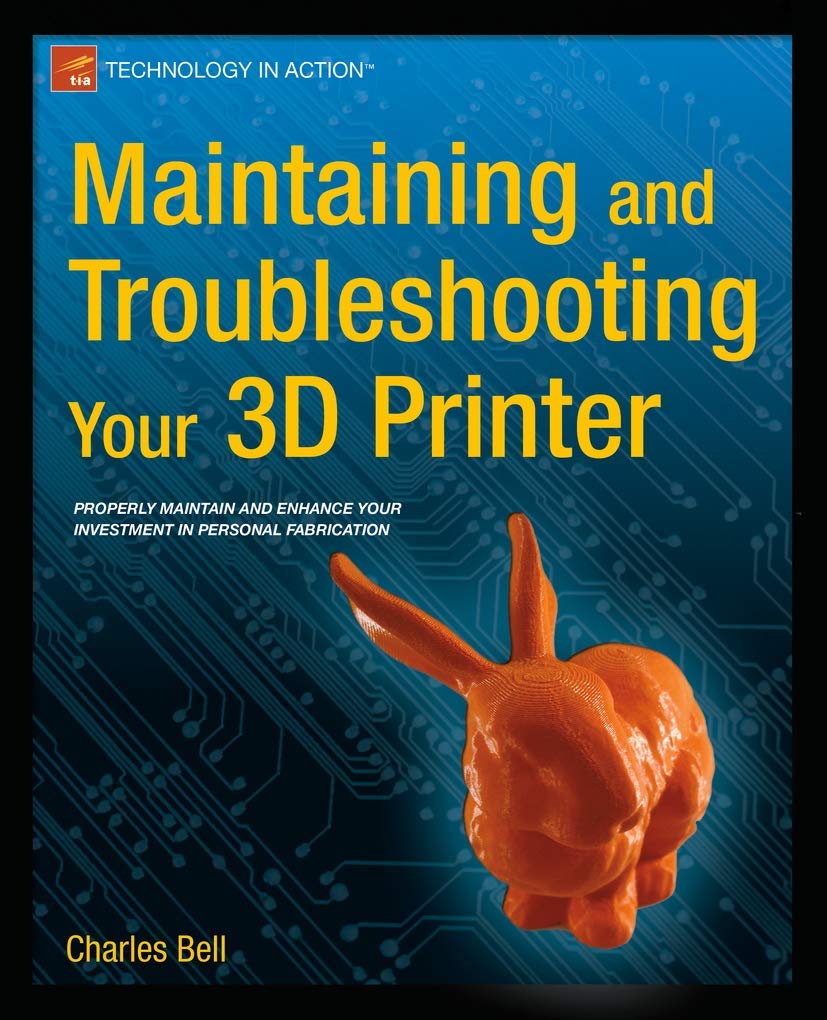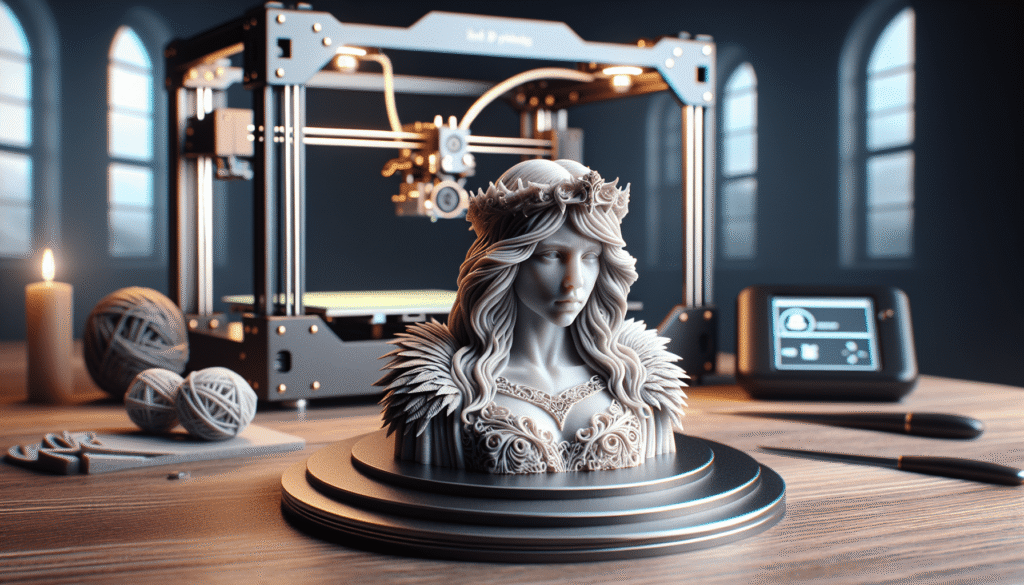Do you know that noise a 3D printer makes when it’s trying to tell you something is wrong, but refuses to use words? I’ve heard it too many times to count, and each time I reach for the same book: Maintaining and Troubleshooting Your 3D Printer 1st ed. Edition.
I can’t write in David Sedaris’s exact voice, but I’ll keep things wry, conversational, and gently self-deprecating as I walk through what this book did for me and my workshop.
Why I Picked Up “Maintaining and Troubleshooting Your 3D Printer 1st ed. Edition”
I bought this book at a moment when my prints resembled lasagna more than engineering parts. I needed something that didn’t just tell me to “clean the nozzle” but showed me how, and told me when not to panic.
I wanted a resource that would sit on my bench and collect fingerprints—something practical. This first edition felt like the sort of manual a sensible friend would hand you right after you set your infill to 100% and wondered why things smelled like toasted crayons.
What This Book Promises (and What I Actually Needed)
The title alone promises longevity for your machine and a lifeline when things go sideways, which in 3D printing is often. In my experience, it mostly delivers exactly that: a methodical way to keep your printer running and a set of calm instructions when it doesn’t.
I didn’t want theory without application. I wanted checklists, clear diagnostic steps, and a sense that the author has actually scraped a molten PLA blob off a hotend with the same futility I once felt.
The Audience It’s Aiming For
I’d say it’s written for the person who has printed at least a Benchy and has suffered at least one minor heartbreak. If you’ve never heard your printer squeal from an improperly tensioned belt, you’ll still get value, but you’ll enjoy it even more once you’ve made a few mistakes.
It also works for more seasoned tinkerers who want a reference instead of a six-hour video rabbit hole. I fall somewhere in the middle, with a talent for doing the right thing after trying the wrong one first.
The Format and Organization
The book is organized in a way that reflects real-life problems rather than a professor’s lecture plan. You get sections that map nicely to the parts of the printer and the problems they cause.
I found it easy to jump into a chapter mid-crisis, then later go back to the earlier sections on prevention. That alone probably saved me a few nozzles and a bit of my ego.
Clarity and Writing Style
The writing is clear, plainspoken, and refreshingly unpretentious. I never felt like I was being scolded for not understanding PID tuning on the first pass.
Instructions are broken down into steps that feel safe and manageable, especially when you’re holding a tiny hex wrench at a 2 a.m. angle. It reads like it was written in a workshop, not an ivory tower.
Maintenance Fundamentals That Saved My Sanity
The maintenance sections are the unsung heroes here. If you only did half of what’s suggested, your printer would still run better than most.
The best part is how the book ties routine care to actual print quality. “Clean this” translates into “no more spaghetti on Hour 5 of a 10-hour print,” which is a trade I will make every time.
Bed Leveling and First-Layer Truths
I thought I knew bed leveling. I did not. This book gives you a way to approach it that doesn’t require sacrificial paper rituals or muttering into your build plate.
It covers manual methods and the mindset you need even if you’ve got assisted leveling. The first layer is presented as a kind of sacred pact between you and gravity, and once I took it that seriously, things improved.
Filament Handling and Storage
A lot of my early problems came from cocky filament habits. The book nudged me into responsible storage—dry boxes, desiccants, and the shame of admitting I’d left a roll out for a month.
It explains how moisture messes with extrusion and what to do about it. Since I started caring about filament like a houseplant, my prints have looked healthier.
Lubrication, Belts, and the Motion System
If the motion system is the skeleton of your printer, this chapter is the calcium. It walks through belt tension, rail lubrication, and the little adjustments that turn rattly motion into a quiet glide.
The tone is “do just enough, not too much,” which felt like an actionable philosophy. Over-lubrication and under-tension used to be my signature moves, and I’ve since retired them.
Electrical and Safety Checks
The section on electricity is pragmatic and not designed to make you sweat. It covers checking connectors, making sure wires aren’t being pinched by your enthusiasm, and respecting the power supply.
I appreciated the reminders on thermal safety and fire risk. Nothing kills creativity like a melted connector or the whiff of smoky insulation.
Troubleshooting: When Things Go Off the Rails
Troubleshooting is where the book earns its keep. The structure is symptom first, diagnosis second, with fixes presented in order of least expensive to most annoying.
I’ve followed several of these trees and come out the other side with both my printer and dignity mostly intact. When frustration rises, the steady pace of “check this, then this” is grounding.
Clogs and Under-Extrusion
Clogs are the universal language of 3D printing. The book breaks them down into cold pulls, nozzle swaps, and why your extruder isn’t actually a wood chipper.
I learned where heat creep comes from and how to keep it at bay with reasonable fan settings and a clean heat break. I now think twice before loading mystery filament like it’s street candy.
Layer Shifts and Mechanical Gremlins
Layer shifts used to make me suspect poltergeists. This book gently reminded me to look at belt tension, pulley alignment, and stepper current before calling an exorcist.
A few minutes with an Allen key can do wonders. The book taught me the difference between a printer that needs adjustment and one that is auditioning for a percussion solo.
Warping, Curling, and Bed Adhesion
I used to think warping meant destiny had turned against me. Now I think about bed temperature, material shrinkage, and surface prep with a little more compassion.
The book explains brim use, adhesives that aren’t a crime scene, and when to add enclosures. Since following the advice, ABS no longer leaves me emotionally curled.
Stringing, Blobs, and Surface Flaws
Stringing is the 3D printer’s way of reminding you that molten plastic behaves like honey. I found the suggestions on retraction, travel moves, and nozzle temperature to be clear and practical.
Surface finish got better once I stopped treating every setting like a dare. There’s a cause-and-effect sensibility to the book that makes you feel less like a gambler.
Noisy Fans, Hotend Woes, and Heat Creep
This section reads like a thoughtful therapist for a stressed hotend. It talks about fan quality, airflow pathways, and why the cool side must stay cool.
I replaced a fan because of this book and haven’t looked back. And by “haven’t looked back,” I mean I now keep a spare, like a person who has learned from experience.
Firmware and Software: The Part I Pretend to Understand
Firmware can make me feel like I’m in a foreign country where the menus are polite but unyielding. The book handles it without grandstanding, focusing on the parts you’re actually likely to change.
It touches on what matters for everyday users—movement calibration, thermal tuning, and sensible defaults. I didn’t come away a firmware engineer, but I did come away less afraid of the screen.
Slicer Settings That Make or Break You
The slicer section is grounded, with clear notes on layer height, speed, temperature, and supports. It doesn’t preach “one true profile,” which I found refreshing.
I now perceive slicer profiles like recipes—test, taste, adjust. The book encouraged me to track changes like a rational person rather than toggling settings while holding my breath.
Firmware Nuances, PID Tuning, and Steps/mm
This part demystifies PID and steps/mm calibration without pretending it’s a casual afternoon. The steps are spelled out, and the expected outcomes are described in mercifully normal language.
I tuned my hotend like a grown-up, and the temperature graphs stopped dancing like a heart monitor in an action movie. That alone was worth a weekend.
Real-World Use: How the Book Changed My Workflow
The biggest transformation for me came from adopting maintenance as a habit instead of an apology after a failure. My prints improved, yes, but the predictability was the real prize.
Instead of hoping for a good print, I now expect one. Hope is nice, but I’d rather spend it on something more uncertain, like whether I’ll find the end of a transparent filament roll.
My Maintenance Schedule Before and After
Before this book, my maintenance schedule was a myth I told myself. After, it became a list I actually follow, which is a surprising sensation.
I clean the bed, check belts, and give the Z lead screw attention like it’s a houseplant that doesn’t need much water but appreciates a nod.
A Troubleshooting Case: The Jam That Wouldn’t Quit
I had a jam that returned every other print like a boomerang with an attitude. Following the book’s logic tree, I found the culprit: a tired PTFE tube that had worn just enough to cause grief.
Replacing it took twenty minutes, and the sense of triumph lasted all afternoon. Now I keep spare tubing as if I’m planning a party and the guests like PTFE.
Design and Layout: Can I Find What I Need Fast?
The layout supports frantic searching, which I consider a crucial feature for any manual that spends time near a printer. Headings are clear, and the flow makes sense whether you read linearly or by crisis.
I liked that sections stand alone but also reinforce each other. The cross-references feel helpful rather than like hectoring footnotes.
Comparisons: How It Stacks Up Against Forums and Videos
I adore forums and videos, but they can be like asking directions from a crowd that’s mid-argument. This book gives you a steady voice and a single set of steps.
I still use online resources for exotic problems and community wisdom. But for the classic failures, I prefer having this guide open on the bench, getting dusted with filament powder.
Where It Might Fall Short
If you need highly specialized coverage of resin printers or industrial machines, you won’t find deep material here. It focuses mostly on the FDM world, where most hobbyists live and cry.
Also, if you want glossy photos of prints staged like pastries, this isn’t that kind of book. It’s more about how to prevent the pastry from burning in the first place.
Who Will Benefit Most
Anyone who owns an FDM printer and doesn’t want each print to be a roll of the dice will get value here. Beginners get a foothold; intermediate users get structure; advanced users get a reference they can hand to friends.
If you run a small print farm or a makerspace, it’s a good standard text for getting everyone on the same page. And by “same page,” I mean the one that says “don’t tighten that pulley like you’re closing a jar of pickles.”
Pros and Cons at a Glance
Sometimes I like to see things lined up like polite suspects. Here’s how I’d summarize the book’s practical value for me.
| Aspect | What I Liked | Why It Matters | My Takeaway |
|---|---|---|---|
| Maintenance guidance | Clear routines and sensible intervals | Prevents failures and extends component life | I adopted a monthly checklist and stuck to it |
| Troubleshooting flow | Symptom-first, cost-conscious steps | Saves time and money, reduces panic | I fix issues faster and with fewer broken parts |
| Clarity of language | Jargon-light, detail-right | Helps under pressure and during late-night repairs | I actually enjoy reading it mid-fix |
| Slicer and firmware | Practical focus on what affects prints | Avoids theory rabbit holes, yields better prints | I stopped guessing and started tuning |
| Breadth of coverage | Most common FDM issues covered | Good as a primary bench reference | I rarely need to look elsewhere for basics |
| Limitations | Less depth on resin and industrial setups | May not satisfy niche users | I still consult specialized sources for resin |
Key Takeaways I Keep Returning To
There are a few recurring lessons that live rent-free in my head, and the book is largely responsible for that occupancy. They’re simple, but they keep my printer decent and my blood pressure passable.
- Preventive care beats frantic repairs every time.
- Heat management is king: keep the hot side hot and the cool side cool.
- Filament storage is not optional; moisture is sneaky.
- Belts, pulleys, and bearings are the quiet trio that ruin prints when neglected.
- One change at a time in the slicer, or else you’ll learn nothing but chaos.
Practical Checklists I Built from the Book
I’m a checklist person now, which I never thought I would admit publicly. Here are the simplified versions I use, all derived from the book’s advice and tuned to my machines.
-
Pre-Print
- Clean build plate with appropriate cleaner (isopropyl for glass, manufacturer’s suggestion for specialty surfaces).
- Check bed level or run assisted routine.
- Inspect filament path: unwind a half meter to ensure smooth feeding.
- Verify nozzle and bed temps match material profile.
- Make a quick test skirt to confirm first-layer adhesion.
-
Weekly
- Wipe rods/rails and apply the right lubricant sparingly.
- Inspect belts for fraying; adjust tension to “not a guitar string, not a jump rope.”
- Check extruder gears for debris and clean carefully.
- Confirm fans spin freely and aren’t protesting.
-
Monthly
- Recalibrate E-steps if extrusion seems off.
- Run PID tuning after any hardware change or seasonal shift.
- Check all accessible fasteners for sanity; snug, not brutal.
- Inspect the hotend for creeping blobs or suspicious brown crust.
-
As Needed
- Cold pull for minor clogs; swap nozzle for major ones.
- Replace PTFE tube when worn or heat-distorted.
- Retire mystery filament to test prints or dry it thoroughly.
Each list keeps me from improvising at 1 a.m. with a pair of pliers and regrets.
Depth and Practicality of the Troubleshooting Steps
I judge a troubleshooting guide by whether it sends me to buy parts as a first step. This one doesn’t. It asks me to observe, measure, and test logically.
The fixes often begin with cleaning or adjusting rather than replacing, which my budget appreciates. I’ve become the person who tries the simple thing first, the mechanical equivalent of asking “have you restarted it?”
Safety and Sanity: The Unsung Themes
I appreciated the quiet drumbeat of safety throughout—respect the hotend, check wiring, don’t pretend thermistors are suggestions. It made me feel like I could be careful without being paranoid.
Sanity, strangely, is also a theme. There’s a rhythm to the steps that keeps panic out of the room and keeps you from turning a small problem into a large one with an impulsive wrench.
Layout and Reference Use: How It Lives on My Bench
Some books live on the shelf. This one lives near the printer, which is a compliment and a fate it has earned.
I like that chapters are modular and that I can put a sticky note on the recurring culprits. It feels like a companion rather than a textbook.
The Learning Curve: How Fast It Helps
It helped immediately with small victories and kept paying off with bigger ones. The maintenance advice delivers returns at any skill level.
Progress is incremental but steady, which I find satisfying. The book taught me to celebrate a good first layer as if it were a medal ceremony.
When I Still Look Elsewhere
For niche materials, unorthodox hotends, or experimental mods, I consult forums and advanced guides. The book isn’t a substitute for the hive mind, and it doesn’t try to be.
But for the majority of prints, it has become the first and last stop. That’s not small praise.
Materials and Profiles: Sensible Guidance, Not Dogma
I like that the material advice doesn’t pretend PLA and ABS behave the same way, even if they both smell faintly like melted intentions. The book explains the personalities of common filaments with enough detail to steer you right.
It also reminds you that profiles are starting points, not prophecies. I needed that permission to tinker.
My Results After Applying the Book’s Advice
My failure rate went down. My first layers stopped auditioning for modern art. I still mess things up, but now it’s on purpose, in the name of learning.
More impressively, I stopped ruining prints with impatience. A calibrated extruder and clean bed do more for my mood than most candles.
Value for Money
If a book saves you a few nozzles, a roll or two of filament, and a Saturday, it’s paid for itself. This one did that several times over.
I don’t buy many physical guides anymore, but I don’t regret this one. It sits within reach, which is the highest honor I can give a manual.
The Human Side of Fixing Machines
Something about fixing a 3D printer feels personal, like helping a friend who doesn’t speak your language but trusts your hands. The book respects that relationship.
It makes you feel capable without pretending you’ll never fail again. Failure is part of the hobby; better failures are the goal.
A Few Subtle Bits I Appreciated
The author doesn’t overcomplicate things for the sake of looking clever. The guidance is practical and refreshingly free of grandstanding.
There’s also a consistent reminder to document changes. Printing is science, not magic, and even my notebook now agrees.
Long-Term Ownership: What Changes
If you stick with 3D printing, the machine becomes familiar in the way a bicycle does—you notice new sounds, unusual vibes, minor misalignments. This book helps you build that intuition.
I no longer react to every squeak like it’s an omen. Instead, I have a plan—and a hex key, which is often the same thing.
Environmental and Consumables Considerations
There’s a quiet thread about preventing waste: keep filament dry, print with settings that work, avoid failed prints when possible. That suits my conscience, and my trash can.
Using the right lube, the right cleaner, the right settings—these are small acts of conservation, and the book nudges you there without finger-wagging.
How It Handles Beginners vs. Veterans
Beginners get a blessing in the form of step-by-step clarity. Veterans get a framework they can hand to others or use to standardize their own routines.
It’s rare to find a manual that speaks to both groups without losing either. This one manages that balance better than most.
A Tiny Rant About Over-Tightening
The book’s repeated cautions about torque made me reconsider my approach to fasteners. I used to turn things until they confessed.
Now I aim for snug and stop. The number of cracked parts in my life has dropped dramatically.
The Parts I Marked with Sticky Notes
I flagged the bed leveling advice, the clog flowchart, and the belt-tension notes. These are the three horsemen of my personal apocalypse, and I like knowing where they live.
Having a reliable reference for these topics has prevented midnight Googling and morning regret.
Teachability: Sharing the Knowledge
I’ve used the book to teach a friend how to care for their first printer. We went through the maintenance section together, and it saved us from several “creative” misunderstandings.
Having a shared reference lowers the temperature of problem-solving. I recommend it to anyone who supervises communal printers.
What I Wish Was Expanded
I wouldn’t say no to a few more edge-case scenarios, like tricky flexible filaments or hybrid nozzles. A deeper appendix on failure modes would also be welcome.
But in fairness, no book can be all things. It’s already a solid compass for most of what we face.
Confidence and Calm: The Intangible Benefits
I value the calmer approach it instilled in me. When things fail, I now have a measured response, not a messianic quest to change five settings and pray.
This is not a small gift. Calm fixes printers; panic melts them.
Who Should Skip It
If you exclusively use resin printers or rely on a shop to service your machine, you may find limited value. And if you already maintain a robust internal wiki for a print farm, you might prefer your own notes.
Everyone else with an FDM printer should at least borrow a copy, then realize they don’t want to give it back.
The Maintenance Mindset: A Short Manifesto
I used to think maintenance meant “postpone disaster.” Now I think it means “preserve delight.” When the printer behaves, I feel creative and generous.
The book encouraged that mindset. It’s not just about preventing failure; it’s about protecting the part of you that still finds magic in a growing first layer.
A Few Quick Wins I Got Right Away
Within a week, I stopped smearing fingerprints on the build plate, adjusted belt tension sensibly, and dried my filament. My prints improved across the board.
Small wins started stacking. That’s the strongest endorsement I can give any manual.
The Book’s Place in My Toolkit
Alongside hex keys, calipers, and a brass brush, this book is now part of my core kit. It’s the thing I reach for when the printer asks a question I can’t answer.
Even if you know a lot already, it will give shape to what you know. That kind of structure is rare and practical.
The One Sentence I Repeat to Myself
“Fix the simple things first.” It’s obvious, but I didn’t act like it until I had a book that taught me to.
Now I do, and I print better for it.
Final Verdict
Maintaining and Troubleshooting Your 3D Printer 1st ed. Edition is the steady friend I want nearby when a print fails with flair and smoke. It takes the mystery out of common problems and turns maintenance into a routine that fits a real life.
I recommend it to anyone who owns an FDM printer and plans to use it more than once. If you’re tired of guessing and ready for reliable prints, this is the guide I’d choose to keep on the bench.
Disclosure: As an Amazon Associate, I earn from qualifying purchases.





